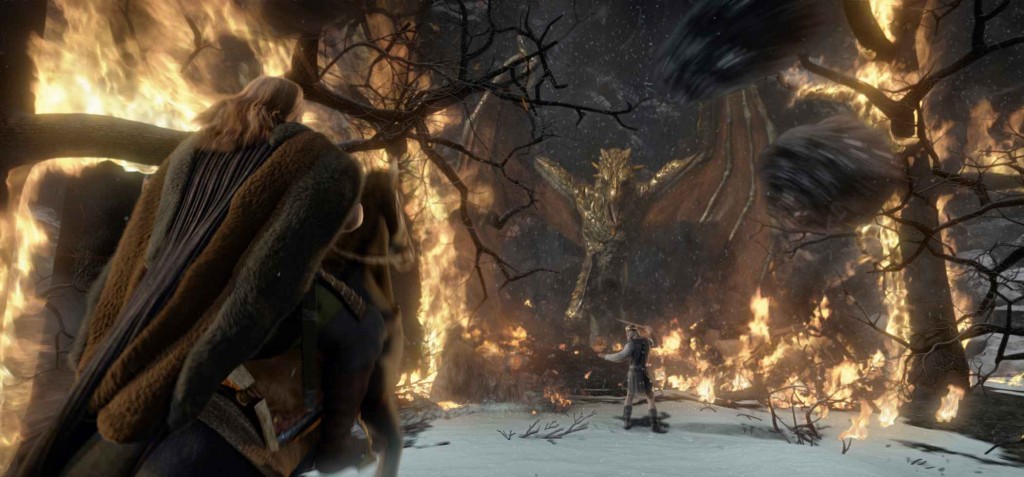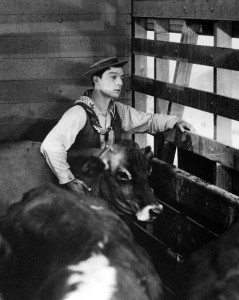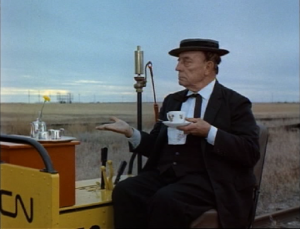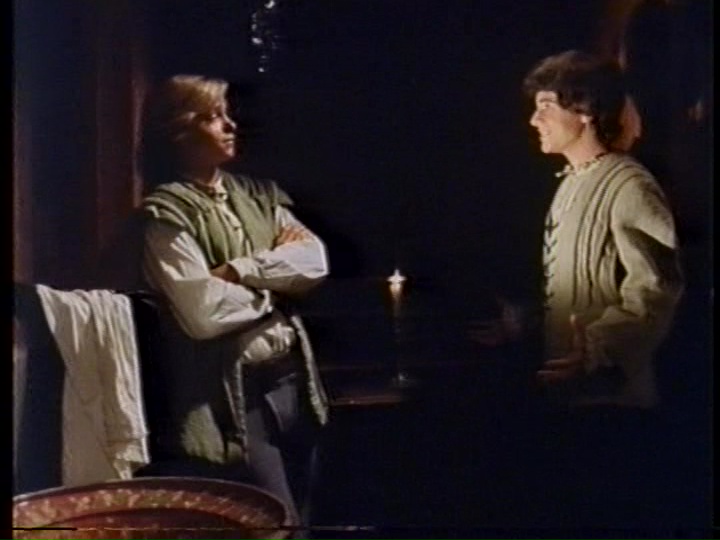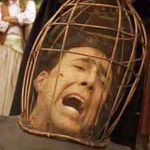I was satisfied with this performance-capture animated version of the Beowulf epic. It doesn’t have much to do with the original Anglo-Saxon epic, but mythology is, by its very nature, open to any mutation the re-teller cares to make. Who the hell knows what transformations the story experienced before our “literary” version appeared? No one objected when Allan Gardner turned the story on its head in his novel “Grendel”. This animated version is an even greater departure, but it held my attention and was visually pleasing.
Category Archives: DN - Viewing 2008 - Page 2
Buster Keaton, A Hard Act to Follow: From Vaudeville to Movies + 10 Keaton shorts
I acknowledge Charlie Chaplin’s genius, but I have to say that his screen personality never appealed to me, and I appreciate his films with a detached, technical eye. Buster Keaton is another thing entirely, for me. His comic genius touches me directly. I laugh when I see Keaton’s silent classics. I was first exposed to his work as a child. The last film he made, before his death, was a short promotional film for the CNR”s coast-to-coast passenger service across Canada. His stone-faced character crosses the country on a railway hand-car. Keaton was as brilliant in it as in any film he had made a half-century before. Read more »
(Hunt 1982) The Mysterious Stranger; (Bridges 1984) Pudd’nhead Wilson
Back in the 1980’s, Nebraska Public Television undertook an ambitious project of filming Mark Twain’s less famous books and stories. These were low-budget affairs, but they had the merit of remaining faithful to Twain’s texts.
Puddin’head Wilson is difficult for an audience of today to assimilate. Few modern viewers understand the social complexities of slavery in pre-Civil War America. Twain’s novel was written in 1893, and set in the period 1630–1850. It turns on a “switched babies” plot device, with a slave and a free baby living out the consequences. The laws of slavery permitted someone who was 1/32 black to be enslaved, so this is perfectly credible. Few now realize that many slaves were in this category. Twain’s bitter satire examines, in turn, all the pretensions, contradictions, and hypocrisies of a slave-holding society. Only one character, Puddin’head Wilson, comes off favourably. He is the only one who seems to care about truth, and not to be driven by greed, revenge, or pretension. Naturally, he is dismissed by all as a “pudd’nhead”, a fool. The low-budget TV film was reasonably well-crafted, and boasted a fine performance by Lise Hilbodt.
But most intriguing is The Mysterious Stranger. This bizarre story did not exist in any definitive edition until 1982. Twain worked on it for twenty years, producing three extremely different versions, all of which remained unpublished. His literary executor, Albert Bigelow Paine, issued a composite version in 1916. The film sticks closest to this version, with some elements of the others. It’s set in Renaissance Austria, where a strange youth, calling himself “No. 44, New Series 864962” appears amidst the apprentices of a printing firm. His ability to perform sundry miracles, and to travel anywhere in time and space, are revealed to one of the apprentices. The film version hints at Twain’s pessimistic world-view, which some have described as “existentialist”, though this unduly trivializes it. Twain struggled all his life to reconcile conflicting attitudes about himself and humanity, and no story of his shows it more than this one. This film version retains enough of the metaphysical spookiness and religious skepticism to ensure that it would come as something of a shock to any American public school or “family” audience that saw it. The public is used to denatured, candified film versions of Twain. Actually, it had more success in Europe, where it was filmed, than in America. The young television actor, Lance Kerwin, gave a surprisingly subtle performance as No.44, though for some reason, he was not given the star billing — probably because the character played by Canadian child star Chris Makepeace is technically the protagonist. Also, Kerwin had been was mainly a television actor, while Makepeace had scored success in film with Meatballs (1979) and My Bodyguard (1980).
(Bogart 1967) Mark Twain Tonight!
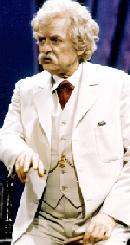 Hal Holbrook’s one-man stage show, in which he reproduces Mark Twain’s nineteenth century stage appearances, is perhaps the most exact and subtle representation of any pre-cinema era historic figure undertaken by any actor. It’s not just Holbrook’s technical virtuosity, but the taste and intelligence with which he selected from Twain’s writings that makes the performance unforgettable. Much of this material is highly relevant today. Twain was not a simple man. His ambiguities have fascinated both historians and lovers of literature since he left the world’s stage (just as he entered it) with Haley’s comet. Holbrook captures this. The 1967 CBS broadcast of the Broadway show must have been one of the most amazing television events of its time. It’s available from Kultur, a company that specializes in preserving notable stage performances on DVD.
Hal Holbrook’s one-man stage show, in which he reproduces Mark Twain’s nineteenth century stage appearances, is perhaps the most exact and subtle representation of any pre-cinema era historic figure undertaken by any actor. It’s not just Holbrook’s technical virtuosity, but the taste and intelligence with which he selected from Twain’s writings that makes the performance unforgettable. Much of this material is highly relevant today. Twain was not a simple man. His ambiguities have fascinated both historians and lovers of literature since he left the world’s stage (just as he entered it) with Haley’s comet. Holbrook captures this. The 1967 CBS broadcast of the Broadway show must have been one of the most amazing television events of its time. It’s available from Kultur, a company that specializes in preserving notable stage performances on DVD.
(Ceylan 2002) Uzak [Distant]
![08-05-13 VIEW (Ceylan 2002) Uzak [Distant]](http://www.philpaine.com/wp-content/uploads/2010/07/viewing-2008-apr-jun-Uzak-300x174.jpg) This is a slow-paced psychological drama, stylistically influenced by Tarkovsky. It holds attention because the acting is superb, the psychological nuances realistic. One scene, for example, involving a lost watch, stands out for the fine-tuned performances of the two lead actors, Muzaffer Ozdemir and Emin Toprak. Sadly, Toprak died in a car crash shortly after learning he had received his award at Cannes. The cinematography is first rate, with Istanbul buried in snow forming a grey backdrop to the claustrophobic interior shots and tightly repressed relationships of the characters. It’s a grim film, but the sympathy of the script makes this tolerable to the viewer, and the camera conveys both the beauty and the bleakness of a Turkish winter.
This is a slow-paced psychological drama, stylistically influenced by Tarkovsky. It holds attention because the acting is superb, the psychological nuances realistic. One scene, for example, involving a lost watch, stands out for the fine-tuned performances of the two lead actors, Muzaffer Ozdemir and Emin Toprak. Sadly, Toprak died in a car crash shortly after learning he had received his award at Cannes. The cinematography is first rate, with Istanbul buried in snow forming a grey backdrop to the claustrophobic interior shots and tightly repressed relationships of the characters. It’s a grim film, but the sympathy of the script makes this tolerable to the viewer, and the camera conveys both the beauty and the bleakness of a Turkish winter.
(Hernández 1999) Lisboa [Lisbon]
A well-crafted suspense film employing some of the formulas of Hitchcock. Despite the title, it’s a Spanish film. The main character is a Portuguese video distributor, on a car trip from Spain, going home. He picks up a mysterious woman, and gets tangled in a web of murder. Well-trodden material, but director Hernandez handles it well, and the oddly low-key ending is original.
(LaBute 2006) The Wicker Man —- ludicrous remake
Okay, I’ve finally seen it. When I heard there was an American remake of the classic 1973 British film I knew it would have to be bad. When it came out, everyone who saw it assured me that it was not just terrible, but an absolute atrocity. But still, I was not prepared for how unbelievably bad this film is. It’s sickeningly, loathsomely, horribly, hideously, insultingly bad. Not even the hilarious sight of Nicholas Cage punching an Evil Wiccan Feminist while dressed in a bear suit can make it seem charmingly bad, like an Ed Wood movie, or Robot Monster. The insult to the original film is simply too monstrous to permit that kind of pleasure. This was made by morons who understand nothing. The best way to watch it, if you must, would be to be dead drunk, stoned out of your mind, or, better yet, in a clinical coma.
(Linklater 2001) Waking Life

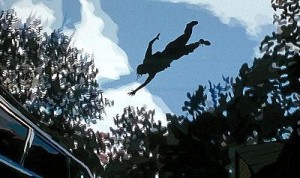 Richard Linklater’s Dazed and Confused (1993) has an enduring popularity. It was an ensemble piece, focusing on a dozen characters, all young, unknown actors at the time. Ben Affleck, among them, went on to a major film career. But whenever I discuss the film with anyone, they always fix on one performance, that of Wiley Wiggins, who played an amazingly likable character that saved the film from being too patly cynical. Linklater wisely employed Wiggins again to play the central character in Waking Life. This offbeat 2001 film employs a combination of rotoscope and computer animation. Rotoscoping is a technique that is usually annoying, but here it works perfectly to put across the idea of lucid dreaming. The story line involves a character who is trapped in a dream about being trapped in a dream, and suspicious that he is actually dead. He constantly encounters characters who lecture him on various conventional philosophical notions ― the standard repertoire of Existentialism, Postmodernism, etc, the kind of stuff that usually makes me cringe. But the warmth of Wiggins’ personality (his character is never named) makes it all work, and the animation’s shifting styles and visual jokes are perfect for portraying dream states. Some of the segments are quite beautiful.
Richard Linklater’s Dazed and Confused (1993) has an enduring popularity. It was an ensemble piece, focusing on a dozen characters, all young, unknown actors at the time. Ben Affleck, among them, went on to a major film career. But whenever I discuss the film with anyone, they always fix on one performance, that of Wiley Wiggins, who played an amazingly likable character that saved the film from being too patly cynical. Linklater wisely employed Wiggins again to play the central character in Waking Life. This offbeat 2001 film employs a combination of rotoscope and computer animation. Rotoscoping is a technique that is usually annoying, but here it works perfectly to put across the idea of lucid dreaming. The story line involves a character who is trapped in a dream about being trapped in a dream, and suspicious that he is actually dead. He constantly encounters characters who lecture him on various conventional philosophical notions ― the standard repertoire of Existentialism, Postmodernism, etc, the kind of stuff that usually makes me cringe. But the warmth of Wiggins’ personality (his character is never named) makes it all work, and the animation’s shifting styles and visual jokes are perfect for portraying dream states. Some of the segments are quite beautiful.
(Hitchcock 1935) The 39 Steps
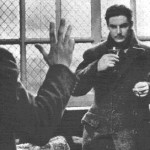 This is a film classic that holds up rather well. John Buchan’s spy thriller, published in 1915, formed the template for hundreds of future stories. It certainly provided the formula that Hitchcock repeated in many of his films: an innocent man, ordinary enough, but cheerful, resourceful, and modestly brave, accidentally gets entangled in a complicated espionage scheme, gets framed for murder, goes on the run, and has to foil the spies to clear his name. The chase takes him across country, a pilgrim’s progress through a sequence of encounters with comical and sinister characters, and finds love along the way. Hitchcock made exactly the film again in Saboteur and North By Northwest. Robert Donat played this kind of hero to perfection, so charmingly that you forget the familiarity of the plot. Hitchcock moved the story up from 1915 to the time of filming, and made the hero, for some reason, a Canadian, but the formula works in any time or place.
This is a film classic that holds up rather well. John Buchan’s spy thriller, published in 1915, formed the template for hundreds of future stories. It certainly provided the formula that Hitchcock repeated in many of his films: an innocent man, ordinary enough, but cheerful, resourceful, and modestly brave, accidentally gets entangled in a complicated espionage scheme, gets framed for murder, goes on the run, and has to foil the spies to clear his name. The chase takes him across country, a pilgrim’s progress through a sequence of encounters with comical and sinister characters, and finds love along the way. Hitchcock made exactly the film again in Saboteur and North By Northwest. Robert Donat played this kind of hero to perfection, so charmingly that you forget the familiarity of the plot. Hitchcock moved the story up from 1915 to the time of filming, and made the hero, for some reason, a Canadian, but the formula works in any time or place.
(Benedek 1953) The Wild One
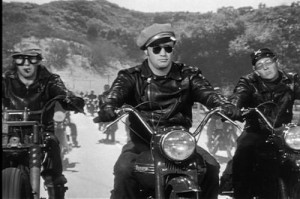 Marlon Brando’s performances were stunning in several fine films of the 1950’s (On The Waterfront, A Streetcar Named Desire, Julius Caesar). But some films just don’t travel well through time. Whatever it was that people saw in this film, widely regarded as a classic, has evaporated. Brando’s performance mesmerized audiences at the time, who seemed to see some kind of pulsating animal magnetism in it. But Brando was already getting pudgy, and the character now just seems to be a complete nitwit. You start laughing in the opening credits, as you see a motorcyle gang “riding” fake motorcycles in front of a projected backdrop. They’re about as menacing as the Brady Bunch. They terrorize a small California town with a reign of impoliteness. Brando has animal magnetism, alright — he looks like a chipmunk in a leather jacket. Whatever this film had then, it just doesn’t work anymore.
Marlon Brando’s performances were stunning in several fine films of the 1950’s (On The Waterfront, A Streetcar Named Desire, Julius Caesar). But some films just don’t travel well through time. Whatever it was that people saw in this film, widely regarded as a classic, has evaporated. Brando’s performance mesmerized audiences at the time, who seemed to see some kind of pulsating animal magnetism in it. But Brando was already getting pudgy, and the character now just seems to be a complete nitwit. You start laughing in the opening credits, as you see a motorcyle gang “riding” fake motorcycles in front of a projected backdrop. They’re about as menacing as the Brady Bunch. They terrorize a small California town with a reign of impoliteness. Brando has animal magnetism, alright — he looks like a chipmunk in a leather jacket. Whatever this film had then, it just doesn’t work anymore.
